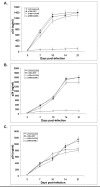Stable gene transfer of CCR5 and CXCR4 siRNAs by sleeping beauty transposon system to confer HIV-1 resistance
- PMID: 18667075
- PMCID: PMC2533343
- DOI: 10.1186/1742-6405-5-16
Stable gene transfer of CCR5 and CXCR4 siRNAs by sleeping beauty transposon system to confer HIV-1 resistance
Abstract
Background: Thus far gene therapy strategies for HIV/AIDS have used either conventional retroviral vectors or lentiviral vectors for gene transfer. Although highly efficient, their use poses a certain degree of risk in terms of viral mediated oncogenesis. Sleeping Beauty (SB) transposon system offers a non-viral method of gene transfer to avoid this possible risk. With respect to conferring HIV resistance, stable knock down of HIV-1 coreceptors CCR5 and CXCR4 by the use of lentiviral vector delivered siRNAs has proved to be a promising strategy to protect cells from HIV-1 infection. In the current studies our aim is to evaluate the utility of SB system for stable gene transfer of CCR5 and CXCR4 siRNA genes to derive HIV resistant cells as a first step towards using this system for gene therapy.
Results: Two well characterized siRNAs against the HIV-1 coreceptors CCR5 and CXCR4 were chosen based on their previous efficacy for the SB transposon gene delivery. The siRNA transgenes were incorporated individually into a modified SB transfer plasmid containing a FACS sortable red fluorescence protein (RFP) reporter and a drug selectable neomycin resistance gene. Gene transfer was achieved by co-delivery with a construct expressing a hyperactive transposase (HSB5) into the GHOST-R3/X4/R5 cell line, which expresses the major HIV receptor CD4 and and the co-receptors CCR5 and CXCR4. SB constructs expressing CCR5 or CXCR4 siRNAs were also transfected into MAGI-CCR5 or MAGI-CXCR4 cell lines, respectively. Near complete downregulation of CCR5 and CXCR4 surface expression was observed in transfected cells. During viral challenge with X4-tropic (NL4.3) or R5-tropic (BaL) HIV-1 strains, the respective transposed cells showed marked viral resistance.
Conclusion: SB transposon system can be used to deliver siRNA genes for stable gene transfer. The siRNA genes against HIV-1 coreceptors CCR5 and CXCR4 are able to downregulate the respective cell surface proteins and thus confer resistance against viral infection by restricting viral entry. These studies have demonstrated for the first time the utility of the non-viral SB system in conferring stable resistance against HIV infection and paved the way for the use of this system for HIV gene therapy studies.
Figures



Similar articles
-
HIV-1 resistance conferred by siRNA cosuppression of CXCR4 and CCR5 coreceptors by a bispecific lentiviral vector.AIDS Res Ther. 2005 Jan 13;2(1):1. doi: 10.1186/1742-6405-2-1. AIDS Res Ther. 2005. PMID: 15813990 Free PMC article.
-
Bispecific short hairpin siRNA constructs targeted to CD4, CXCR4, and CCR5 confer HIV-1 resistance.Oligonucleotides. 2003;13(5):303-12. doi: 10.1089/154545703322616989. Oligonucleotides. 2003. PMID: 15000821
-
CXCR4 and CCR5 shRNA transgenic CD34+ cell derived macrophages are functionally normal and resist HIV-1 infection.Retrovirology. 2005 Aug 18;2:53. doi: 10.1186/1742-4690-2-53. Retrovirology. 2005. PMID: 16109172 Free PMC article.
-
[Deep lung--cellular reaction to HIV].Rev Port Pneumol. 2007 Mar-Apr;13(2):175-212. Rev Port Pneumol. 2007. PMID: 17492233 Review. Portuguese.
-
HIV co-receptors as targets for antiviral therapy.Curr Top Med Chem. 2004;4(9):883-93. doi: 10.2174/1568026043388501. Curr Top Med Chem. 2004. PMID: 15134547 Review.
Cited by
-
Engineering T Cells to Functionally Cure HIV-1 Infection.Mol Ther. 2015 Jul;23(7):1149-1159. doi: 10.1038/mt.2015.70. Epub 2015 Apr 21. Mol Ther. 2015. PMID: 25896251 Free PMC article. Review.
-
Engineering HIV-1-resistant T-cells from short-hairpin RNA-expressing hematopoietic stem/progenitor cells in humanized BLT mice.PLoS One. 2012;7(12):e53492. doi: 10.1371/journal.pone.0053492. Epub 2012 Dec 31. PLoS One. 2012. PMID: 23300932 Free PMC article.
-
Zinc finger protein designed to target 2-long terminal repeat junctions interferes with human immunodeficiency virus integration.Hum Gene Ther. 2012 Sep;23(9):932-42. doi: 10.1089/hum.2011.124. Epub 2012 May 8. Hum Gene Ther. 2012. PMID: 22429108 Free PMC article.
-
C-C chemokine receptor type five (CCR5): An emerging target for the control of HIV infection.Appl Transl Genom. 2013 May 26;2:3-16. doi: 10.1016/j.atg.2013.05.004. eCollection 2013 Dec 1. Appl Transl Genom. 2013. PMID: 27942440 Free PMC article. Review.
-
Zinc-finger nuclease editing of human cxcr4 promotes HIV-1 CD4(+) T cell resistance and enrichment.Mol Ther. 2012 Apr;20(4):849-59. doi: 10.1038/mt.2011.310. Epub 2012 Jan 24. Mol Ther. 2012. PMID: 22273578 Free PMC article.
References
-
- Pomerantz RJ, Horn DL. Twenty years of therapy for HIV-1 infection. Nat Med. 2003;9:867–873. - PubMed
-
- Pope M, Haase AT. Transmission, acute HIV-1 infection and the quest for strategies to prevent infection. Nat Med. 2003;9:847–852. - PubMed
-
- Strayer DS, Akkina R, Bunnell BA, Dropulic B, Planelles V, Pomerantz RJ, Rossi JJ, Zaia JA. Current status of gene therapy strategies to treat HIV/AIDS. Mol Ther. 2005;11:823–842. - PubMed
-
- Dropulic B. Genetic modification of hematopoietic cells using retroviral and lentiviral vectors: safety considerations for vector design and delivery into target cells. Curr Hematol Rep. 2005;4:300–304. - PubMed
Grants and funding
LinkOut - more resources
Full Text Sources
Research Materials

